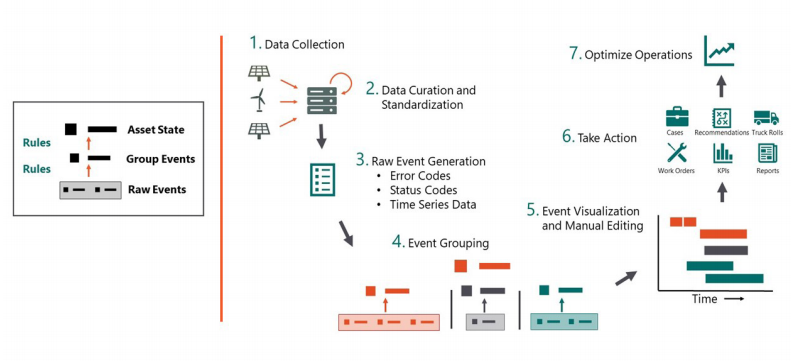Solution Brief: Data and Event Engines
Power Factors’ Data Engine and Event Management curate data and consolidate events to streamline process and enable action.
The continued growth and consolidation of renewable energy portfolios has created a greater need for operational efficiency. Legacy data platforms struggle to highlight onsite behavior that merits operator attention and remediation. Owners and operators need a new way to protect assets through cost-effective asset performance management.
Today’s portfolios present challenges of scale through performance data volume, data system and vendor class heterogeneity, and operational process. For operators, data availability is expected, but action is elusive. Noisy datasets prevent informed, prioritized decision-making, ultimately inhibiting operational optimization.
Power Factors employs an innovative data curation and event management approach that cleans data, suppresses unnecessary events, and combines related events so operators can effortlessly prioritize workflows around surfaced events, optimizing yield, contractual compliance, and revenue.
Data & Event Engines
The Power Factors platform standardizes heterogeneous, high-speed time-series performance data, error codes and status codes from any OEM SCADA, IIoT device, or third-party data acquisition system. Powerful algorithms built on industry-standard cloud platforms then curate data and create events to translate raw information into actionable insights. These tools help asset owners and operators transform O&M strategies.

Fig. 1 Information Processing through Power Factors Data and Event Engines
Once the Data Engine creates homogeneous data sets, the Events Engine simplifies event processing through several logical steps. The platform first calculates raw events from the available data. Similar raw events are then consolidated into parental Group Events through an applied set of industry standard rules. Finally, Event Groups yield specific asset states through another set of standard rules. Overall, this process introduces logic and structure that removes noise and enables operators to prioritize maintenance workflows and manage cases that align with defined KPIs.
What to Expect
The Power Factors platform is designed to curate data, convert raw time series data and organize fault codes to identify events impacting cost of production. Through consolidation, suppression, filtering, and shelving, the Power Factors Event Manager enables:
- Understanding impacts. Instead of sifting through noisy alerts, events without impact are automatically suppressed by design. Important events are tagged with higher-level parameters like lost energy, rate of lost energy, lost revenue and rate of lost revenue so users can easily filter events according to operational impact. Event contextualization allows for more effective operator decision-making and unlocks innovative new O&M strategies
- Situational flexibility. Users can apply conditions to optimize event prioritization. For example, shelve events by asset class and event type for a user-defined time period such as a scheduled work order to reduce noise caused by known activity. Users can also modify threshold parameters to account for varying tolerances or local operating conditions
- More focus on events that matter. Instead of processing hundreds of redundant pieces of information from performance data, error codes, and status codes, the Power Factors Event Manager groups events to show a single asset state using industry-standard Event Rules, reducing the processing time required to convert raw data into action.
| Feature | Function |
|---|---|
| Event Generation |
Gathers raw data produced by assets via standard protocols Creates events derived from time-series data Identifies events based on asset error codes and operating states |
| Event Visualization |
Visualizes events in dashboards Allows drill-downs into events, showing associated trends and event Gantt charts for contextualization |
| Event Notification |
Sends alert via email to users subscribed for specific events Supports notifications on raw events from source system Supports notifications on group events |
| Event Reporting | Calculates KPIs such as Availability and Lost Production based on industry standards, e.g., IEC 61400-26-2 Production-Based Availability Renders built-in reports such as Bad Actors Report (i.e., assets with highest lost production, lowest availability, etc.) Advanced reporting use cases enabled through BI/Cube clients |
| Event Editing | Allows users to manually split/merge group events Supports event bulk editing and classification Query and display matching events Modify event category, start/stop time, and more Includes event change log for auditing |
| Event Data Model |
Defines event data model including parent/child relationships Stores and manages event data in relational database Includes event templates for Wind/Solar assets Associates event templates to asset templates |
| Event Categorization |
Supports standard and automated event categorization, including mapping to NERC GADS specifications and IEC standards |
| Event Aggregation |
Employs logic to group/associate related events Defines and uses prioritization rules within the context of each group |
| Event Curation | Employs logic to determine valid vs. invalid events and automated rules to identify and filter out invalid/spurious events |
| Event Data API | Support full CRUDQ operations on events, i.e., create/read/update/delete/query events and event attributes Writes manual event modifications to the audit log |
Summary
Renewable energy asset owners and operators are clear in their desire to use data and exception-based events to maximize revenue streams, but they are burdened by the sheer volume and redundancy of the real-time information that confronts them. This information overload prevents them from adequately discerning relevant from non-relevant events and prioritizing them according to their effects on operational KPIs.
The Power Factors Data Engine and Event Manager curate data, apply standardized rules and grouping strategies to surface relevant events, shelve and suppress events according to real-time conditions, and enable operators to prioritize according to operational KPIs.
For More Information
To learn more about how the Power Factors asset performance management platform works, please contact sales@pfdrive.com or visit www.pfdrive.com
